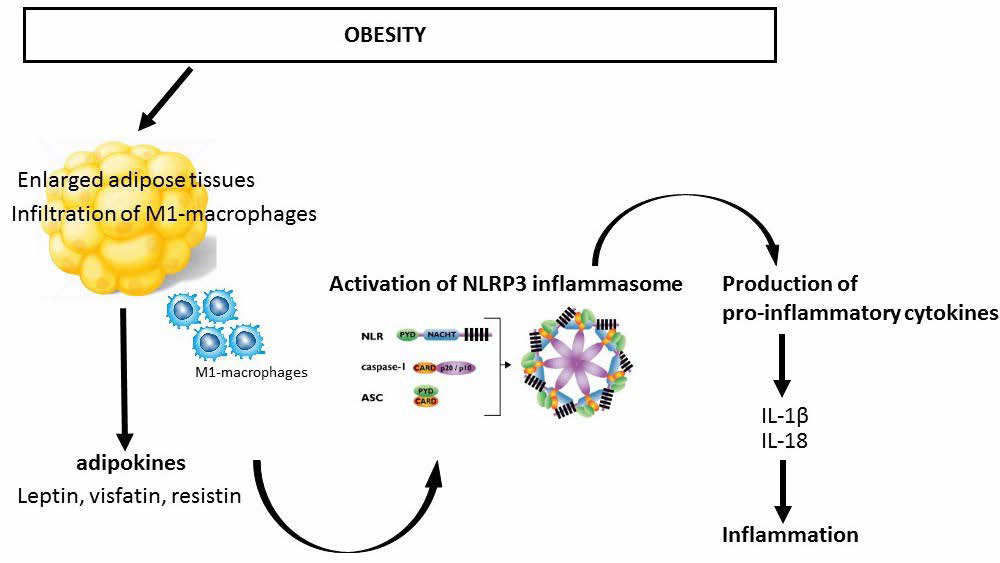1. Pan H, Guo J, Su Z. Advances in understanding the interrelations between leptin resistance and obesity. Pysiol Behav. 2014; 130: 157-169. doi: 10.1016/j.physbeh.2014.04.003
2. Allison MB, Myers MG. 20 Years or leptin: Connecting leptin signaling to biological function. J. Endrocrinol. 2014; 223(1): T25- T35. doi: 10.1530/JOE-14-0404
3. Drent ML, Klok MD, Jakobsdottir S. The role of leptin and ghrelin in the regulation of food intake and body weight in humans: A review. Obes Rev. 2007; 8(1): 21-34. doi: 10.1111/j.1467- 789X.2006.00270.x
4. Iikuni N, Lam QLK, Lu L, et al. Leptin and Inflammation. Curr Immunol Rev. 2008; 4(2): 70-79. doi: 10.2174/157339508784325046
5. Groß CJ, Mishra R, Schneider KS, et al. K+ Efflux-Independent NLRP3 Inflammasome activation by small molecules targeting mitochondria. Immunity. 2016; 45: 761-773. doi: 10.1016/j.immuni.2016.08.010
6. Mortimer L,Moreau F, MacDonald JA, Chadee K. NLRP3 inflammasome inhibition is disrupted in a group of auto-inflammatory disease CAPS mutations. Nat Immunol. 2016; 17(10): 1176- 1186. doi: 10.1038/ni.3538
7. Shuttleworth S, Townsend P, Silva F, et al. Progress in the development of small molecule therapeutics targeting Th17 cell function for the treatment of immune-inflammatory diseases. Prog Med Chem. 2011; 50: 109-133. doi: 10.1016/B978-0-12-381290- 2.00003-3
8. Fu S, Xu L, Li S, et al. Baicalin suppresses NLRP3 inflammasome and nuclear factor-kappa B (NF-κB) signaling during Haemophilus parasuis infection. Vet Res. 2016; 47(1): 80. doi: 10.1186/s13567- 016-0359-4
9. De Rosa V, Procaccini VC, Cali G, et al. A key role of leptin in the control of regulatory T cell proliferation. Immunity. 2007; 26(2): 241-255. doi: 10.1016/j.immuni.2007.01.011
10. Reed JC, Doctor K, Rojas A, et al. Comparative analysis of apoptosis and inflammation genes of mice and humans. Genome Res. 2003; 13(6B): 1376-1388. doi: 10.1101/gr.1053803
11. Ting JP, Lovering RC, Alnemri ES, et al. The NLR gene family: A standard nomenclature. Immunity. 2008; 28(3): 285-287. doi: 10.1016/j.immuni.2008.02.005
12. Fu S, Lei L, Lei H, Yiyun Y. Leptin promotes IL-18 secretion by activating the NLRP3 inlammasome in RAW 264.7 cells. Mol Med Rep. 2017; 16(6): 9770-9776. doi: 10.3892/mmr.2017.7797
13. Zhong, Yifei, Anna Kinio, and Maya Saleh. Functions of NOD-like receptors in human disease. Front Immunol. 2013; 4: 333. doi: 10.3389/fimmu.2013.00333
14. Bo-Zong S, Zhe-Qi X, Bin-Ze H, et al. NLRP3 inflammasome and its inhibitors: A review. Front Pharmacol. 2015; 6: 262. doi: 10.3389/fphar.2015.00262
15. Franchi L, Eigenbrod T, Munoz-Panillo R, et al. Cytosolic double-stranded RNA activates the NLRP3 inflammasome via MAVSinduced membrane permeabilization and K+ efflux. J Immunol. 2014; 193(8): 4214-4222. doi: 10.4049/jimmunol.1400582
16. Ozaki E, Campbell M, Doyle SL. Targeting the NLRP3 inflammasome in chronic inflammatory diseases: Current perspectives. J Inflamm Res. 2015; 8: 15-27. doi: 10.2147/JIR.S51250
17. Schroder K. Tschopp J. The inflammasomes. Cell. 2010; 140(6): 821-832. doi: 10.1016/j.cell.2010.01.040
18. Gross O, Thomas CJ, Guarda G, Tschopp J. The inflammasome: An integrated view. Immunol Rev. 2011; 243(1): 136-151. doi: 10.1111/j.1600-065X.2011.01046.x
19. De Zoete MR, Palm NW, Zhu S, Flavell RA. Inflammasomes. Cold Spring Harb Perspect Biol. 2014; 6(12): 1-22. doi: 10.1101/cshperspect.a016287
20. Masters SL, Dunne A, Subramanian SL, et al. Activation of the NLRP3 inflammasome by islet amyloid polypeptide provides a mechanism for enhanced IL-1β in type 2 diabetes. Nat Immunol. 2010; 11(10): 897-904. doi: 10.1038/ni.1935
21. Stienstra R, Tack CJ, Kanneganti TD, et al. The Inflammasome Puts Obesity in the Danger Zone. Cell Metab. 2012; 15:10-18. doi: 10.1016/j.cmet.2011.10.011
22. Olefsky JM, Glass CK. Macrophages, inflammation, and insulin resistance. Annu Rev Physiol. 2010; 72: 219-246. doi: 10.1146/ annurev-physiol-021909-135846
23. Shoelson SE, L. Herrero, and A. Naaz. Obesity, inflammation, and insulin resistance. Gastroenterology. 2007; 132(6): 2169-2180. doi: 10.1053/j.gastro.2007.03.059
24. Jager, J, Gremeaux T, Cormont M, et al. Interleukin-1 betainduced insulin resistance in adipocytes through down-regulation of insulin receptor substrate-1 expression. Endocrinology. 2007; 148: 241-251 doi: 10.1210/en.2006-0692
25. Netea MG, Joosten LA, Lewis E, et al. Deficiency of interleukin-18 in mice leads to hyperphagia, obesity and insulin resistance. Nat Med. 2006; 12(6): 650-656. doi: 10.1038/nm1415
26. Zorrilla EP, Sanchez-Alavez M, Sugama S, et al. Interleukin-18 controls energy homeostasis by suppressing appetite and feed efficiency. Proc Natl Acad Sci USA. 2007; 104(26): 11097-11102. doi: 10.1073/pnas.0611523104
27. Vandanmagsar B, Youm YH, Ravussin A, et al. The NLRP3 inflammasome instigates obesity-induced inflammation and insulin resistance. Nat Med. 2011; 17(2): 179-188. doi: 10.1038/nm.2279
28. Rheinheimer J, De Souza BM, Cardoso NS, et al. Current role of the NLRP3 inflammasome on obesity and insulin resistance: A systemic review. Metabolism. 2017; 74: 1-9. doi: 10.1016/j.metabol.2017.06.002






